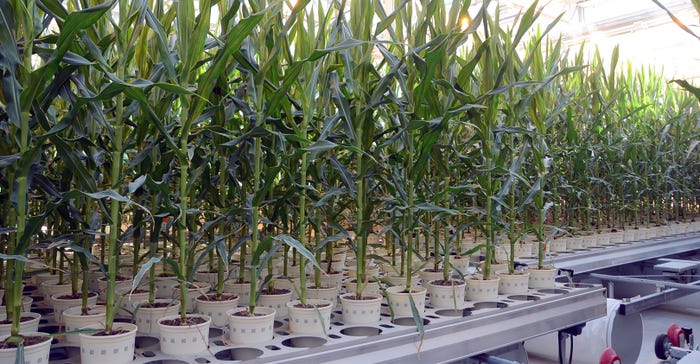March 9, 2020

There's something about crossing the Arizona desert between Phoenix and Tucson that brings back images of the Old West. Those saguaro cacti rising from the rocky hillsides speak of older times, of boot-hill cemeteries and cattle ranges. Yet on the drive now, you’re more likely to see a hot air balloon overhead or the tails of airplanes parked in the desert, which is what a visitor saw on the way to the most advanced seed development facility ever built — the new Bayer Marana Greenhouse.
Called the first of its kind by Bayer, the new facility is a marriage of corn breeding, engineering and data science in a 300,000-square-foot facility designed with sustainability in mind. Farm Progress got a tour, which you can check out in the accompanying slideshow; but what led Bayer to build this facility, and why is it so special?
There are some basic questions there that were answered during the opening ceremonies for the facility held recently. After listening the Mariachi Los Diablitos de Sunnyside from Sunnyside High School entertain the crowd and set the local mood, dignitaries from Bayer and the state of Arizona shared some facts about the facility ahead of the official ribbon cutting.
Matt Lingard, site lead, Bayer Marana Greenhouse, offered some insight into what makes this facility special: “What I was really excited about is that this project uses greenhouse technology, automation and data science to help improve the seed corn that we’re producing for our farmer customers.”
Mike Graham, head of breeding, Bayer Crop Science, talked about the value of the greenhouse in the context of corn seed development. “The big question I always get is, ‘Why a greenhouse?’ If you step back and you think about how a product is developed, it takes us years of field research in open field conditions to develop the next generation of products.”
He pointed out that this creates two issues. One, you’re planting in a field, and in most parts of the world you get one season. The other big challenge? “We do it outside. Anytime you are doing work and research outside, you’re at risk of environmental conditions that may impact your productivity, your production.”
Graham pointed out how the greenhouse makes a difference. “If you flip that around, and you think about what we can do now with a facility like we have here, it’s truly exciting,” he said. “We can plant multiple generations, accelerating product development at a speed and a pace we have never done in the past; and we can do it in a way that by controlling the environment, we’re ensuring that we’re delivering the right amount of seed to our researchers — so they can continue with their [product development].”
Investment and payback
Bob Reiter, head of research and development, Bayer Crop Science, said that this new facility will “basically serve all of Bayer’s global corn market, with the exception of Brazil.” Brazil has crop quarantine issues that make breeding outside the country difficult.
With this facility, researchers can match the growing conditions of every market served, whether day length or temperature. “We can set up growing conditions for all of our genetics,” he noted.

JUST THE FACTS: This information board outlines what went into the building of the new Bayer Marana facility north of Tucson, Ariz.

And a greenhouse that can accelerate breeding makes sense: so why didn’t Bayer build one sooner? “We had to get all the pieces together,” Reiter said. “Essentially, the technology being deployed in the facility hasn't all been around that long.”
The process starts with gene chipping to determine the genetic makeup, and potential, of an individual corn seed. From there, that seed not only has to be grown out, but also tracked from kernel to final cob (eventually kernel again); and all the while, key data must be gathered and analyzed.
“You have to have all of that genomic knowledge and decision-making in place, so that once you have that information, we know what decision to make. So we know which of those thousands of seeds you want to put here and which ones you want to throw away,” Reiter said.
The new greenhouse includes a lot of data management and collection. It has been engineered to incorporate automation for everything from heating and cooling to the way trays of growing plants are moved from place to place. And while there’s automation, today, more than 90 people — most hired locally — are doing the work.
Yet this was a major business decision, one that Bayer management had to take into consideration when looking at the opportunity. The new facility carries a price tag north of $100 million, which is a big investment. Brett Begemann, chief operating officer, Bayer Crop Science, shared that the benefit is twofold. “It’s a step change in the breeding process that Mike Graham was talking about, but it’s scientifically also a step change in managing the environment that we’ve been [breeding corn] in,” he said. “It’s the combination of those two things — and with a year like last year, it was a difficult year for farmers, it was difficult for us, too; for the work that we’re doing in the field, some of it had poor-quality data and information.”
Begemann said this new facility removes that risk from a key part of the breeding process, including seed increase for promising inbreds and early hybrid work, too. “I think the return on something like this … is quick, if you look at the whole picture.”
About the Author(s)
You May Also Like






